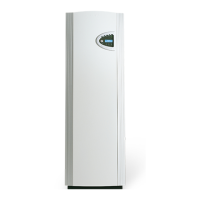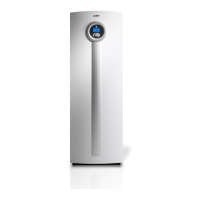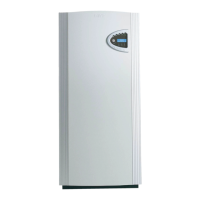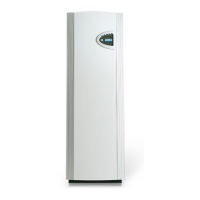Product details
6 720 645 504 (2011/04) en
8
5 Product details
HC 22-33 are ground source pumps designed to be
supplemented with an external hot water heater.
5.1 Application area
The heat pump must only be used in a closed hot water
heating system according to BS EN 12828.
Other forms of use are not permitted. We take no
responsibility for damage occurring due to non-
permitted use.
5.2 Type overview
HC Ground source heat pump
kW Heat output 0/35 (EN 14511)
5.3 Type plate
The type plate is located on the roof plate of the heat
pump. Information about the heat pump's output, part
number, serial number and date of manufacture is stated
there.
5.4 Transport and storage
The heat pump should always be transported and stored
in an upright position. However, the heat pump may be
tilted temporarily, but must not be laid down.
The outer cover plates should be removed to avoid
damage if the heat pump is transported without the
supplied transport pallet.
The heat pump must not be stored at temperatures
below -10 °C.
5.5 Transport locking devices
The heat pump is furnished with transport locking
devices which prevent damage during transportation.
Unscrew the transport locking devices installed next to
the vibration dampers on the heat pump ( figure 9).
5.6 Positioning the heat pump
B The heat pump is placed indoors, on a level and stable
surface that withstands a weight of at least 400 kg.
B Adjust the rubber feet so the heat pump does not
lean.
B The ambient temperature around the heat pump must
be between 10 °C and 35 °C.
B The installer should take noice transfer to adjacent
areas into consideration when positioning the heat
pump.
B There must be a drain in the room where the heat
pump is placed. This ensures that water can easily be
carried away if there is a leak.
5.7 Checks before installation
B Installation of the heat pump should be performed by
a qualified installer.
B Before the heat pump is commissioned, the heating
system, hot water cylinder and the collector circuit
system, including the heat pump, must be filled and
vented.
B Check that all pipe connections are intact and have
not shaken loose during transportation.
B Wiring should be kept as short as possible to protect
the system from downtime, for example during a
thunderstorm.
B Heat pump installation, energy drilling and collector
installation must follow applicable regulations.
B Check the water quality ( page 24, VDI 2035).
5.8 Checklist
1. Position the heat pump on an even base. Adjust the
height using the adjustable feet.
2. Fit the valves, particle filters and a filling unit.
3. Install the incoming and outgoing pipes for the heat
pump, as well as the expansion vessel.
4. Connect the heating unit to the heating system.
5. Install the outdoor sensor and possible room sensors.
6. Fill and vent the heating and collector systems before
commissioning.
7. Carry out the external connections.
8. Connect the heating installation to the power supply.
9. Commission the heating installation by making all the
necessary settings on the control panel.
10. Check the heating installation after commissioning.
11. Top up more collector circuit fluid, if required.
Only qualified installers may carry out the
installation. The installer must follow
applicable rules and regulations and
recommendations from the supplier.
HC HC 22 HC 33
kW 21,0 33,8
Tab. 2 Type overview
Each heat pump installation is unique. The
following checklist will give you a general
description of how the installation should
be carried out.
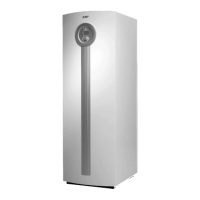
